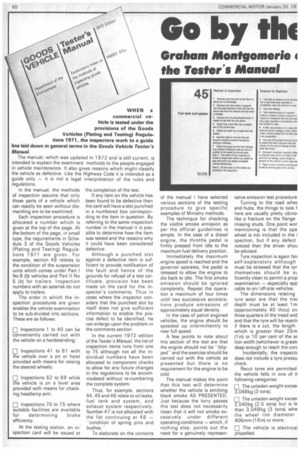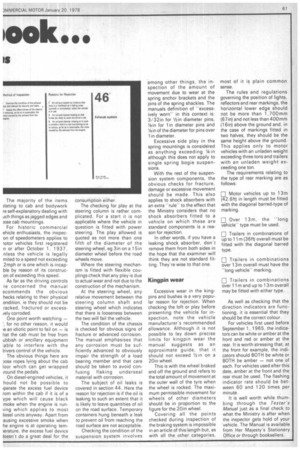Go by Mit
Page 62

Page 63

If you've noticed an error in this article please click here to report it so we can fix it.
Graham Montgomerie 4
the Tester's Manual
In the manual, the methods of inspection assume that only those parts of a vehicle which can readily be seen without dismantling are to be examined.
Each inspection procedure is allocated a number which is given at the top of the page. At the bottom of the page, in small type, the requirements in Schedule 3 of the Goods Vehicles (Plating and Testing) Regulations 1971 are given. For example, section 49 relates to the condition of the suspension units which comes under Part I No 8 (b) vehicles and Part II No 5 (b) for trailers. Inspection numbers with an asterisk do not apply to trailers.
The order in which the inspection procedures are given enables the vehicle examination to be sub-divided into sections. These are as follows: • Inspections 1 to 40 can be conveniently carried out with the vehicle on a hardstanding; • Inspections 41 to 61 with the vehicle over a pit or hoist provided with means for raising the steered wheels; Inspections 62 to 69 while the vehicle is on a level area provided with means for checking headlamp aim; El Inspections 70 to 75 where suitable facilities are available for determining brake efficiency.
At the testing station, an inspection card will be issued at the completion of the test.
If any item on the vehicle has been found to be defective then the card will have a slot punched in a numbered box corresponding to the item in question. By referring to the same inspection number in the manual it is possible to determine how the item was tested and the reasons why it could have been considered defective.
Although a punched slot against a defective item is sufficient to provide notification of the fault and hence of the grounds for refusal of a test certificate, provision has been made on the card for the inspector's comments. Thus in cases where the inspector considers that the punched slot by itself does not give sufficient information to enable the precise defect to be identified, he can enlarge upon the problem in the comments section.
In the current 1972 edition of the Tester's Manual, the list of inspection items runs from one to 75 although not all the individual numbers have been allocated to component checks to allow for any future changes in the regulations to be accommodated without re-numbering the complete system.
Thus, for example, sections 44, 45 and 46 relate to oil leaks, fuel tank and system, and exhaust system respectively. Number 47 is not allocated with the list continuing at 48 — "condition of spring pins and bushes."
To elaborate on the contents of the manual I have selected various sections of the testing procedure to give specific examples of Ministry methods.
The technique for checking the visible smoke emission as per the official guidelines is simple. In the case of a diesel engine, the throttle pedal is firmly pressed from idle to the maximum fuel delivery position.
Immediately the maximum engine speed is reached and the governor operates, the pedal is released to allow the engine to die back to idle. The first smoke emission should be ignored completely. Repeat the operation a maximum of four times until two successive accelerations produce emissions of approximately equal density.
In the case of petrol engined vehicles, the engine should be speeded up intermittently to near full speed.
A few points to note about this section of the test are that the engine should not be "blipped" and the exercise should be carried out with the vehicle as presented but there is no requirement for the engine to be cold.
The manual makes the point that this test will determine whether the vehicle is emitting black smoke AS PRESENTED. Just because the lorry passes this test does not necessarily mean that it will not smoke excessively under different operating conditions — which, if nothing else, points out the need for a genuinely represen tative emission test procedure Turning to the road wheE and hubs, the things to look f here are usually pretty obviol like a fracture on the flange missing studs. One point wor mentioning is that the spa wheel is not included in the i spection, but if any defect noticed then the driver shou be advised.
Tyre inspection is again fair self-explanatory although must be stressed that the tyr themselves should be sk. ficiently clean to permit a prop examination — especially app cable to on/off-site vehicles.
The dimensions relating tyre wear are that the trei. depth must be at least 1 m (approximately 40 thou) ov three quarters of the tread wid and that the tyre will be reject( if there is a cut, the length which is greater than 25m (1 in) or 10 per cent of the se tion width (whichever is great€ deep enough to reach the corc
Incidentally, the inspectit does not include a tyre pressu check.
Recut tyres are permitted the vehicle falls in one of tl following categories: The unladen weight exceei 3,048kg (3 tons); [_] The unladen weight exceel 2,540kg (2.5 tons) but is le than 3,048kg (3 tons) whe the wheel rim diameter 406mm (16in) or more;
Ei The vehicle is electrical propelled.
The majority of the items elating to cab and bodywork re self-explanatory dealing with uch things as jagged edges and )ose cab mountings_ For historic commercial ehicle enthusiasts, the inspecon of speedometers applies to lotor vehicles first registered n or after October 1, 1937, nless the vehicle is legally mited to a speed not exceeding 2mph or is one which is incapble by reason of its construcon of exceeding this speed.
As far as the driving controls re concerned the manual ecornmends the obvious hecks relating to their physical ondition, ie they should not be racked, fractured or excessrely corroded.
One point worth watching for no other reason, it would le an idiotic point to fail on — is hat the cab must be free from ubbish or ancillary equipment able to interfere with the Irivers control of the vehicle.
The obvious things here are Jose ropes lying about the cab loor which can get wrapped round the pedals.
On diesel-erigined vehicles, it hould not be possible to iperate the excess fuel device rom within the cab if it is of a ype which will cause black moke when the engine is runmg which applies to most fiesel units anyway. Apart from ausing excessive smoke when he engine is at operating tern)erature, the excess fuel device loesn't do a great deal for the consumption either.
The checking for play at the steering column is rather complicated. For a start it is not applicable where the vehicle in question is fitted with power steering. The play allowed is quoted as not more than one fifth of the diameter of the steering wheel, eg 3in on a 15in diameter wheel before the road wheels move.
Where the steering mechanism is fitted with flexible couplings check that any play is due to actual wear and not due to the construction of the mechanism.
At the steering wheel, any relative movement between the steering column shaft and steering wheel which indicates that there is looseness between the two will fail the vehicle.
The condition of the chassis is checked for obvious signs of fracture or advanced corrosion. The manual emphasises that any corrosion must be sufficiently advanced to obviously impair the strength of a load bearing member and that care should be taken to avoid confusing flaking underseal material with corrosion.
The subject of oil leaks is covered in section 44. Here the reason for rejection is if the oil is leaking to such an extent that it is likely to leave quantities of oil on the road surface. Temporary containers hung beneath a leak to prevent oil from reaching the road surface are not acceptable.
Checking the condition of the suspension system involves
among other things, the inspection of the amount of movement due to wear at the spring anchor brackets and the pins of the spring shackles. The manuals definition of "excessively. wornin this context is: 3/32in for 1/2in diameter pins, 'Ain for 1in diameter pins and
in of the diameter for pins over lin diameter.
Excessive side play in the spring mountings is considered as anything exceeding 1/4 in although this does not apply to single spring bogie suspensions.
With the rest of the suspension system components, the obvious checks for fracture, damage or excessive movement should be made. This also applies to shock absorbers with an extra ''rule'' to the effect that the Ministry considers that no shock absorbers fitted to a vehicle on which these are standard components is a reason for rejection.
In other words, if you have a leaking shock absorber, don't remove them from both sides in the hope that the examiner will think they are not standard fitting. They're wise to that one.
Kingpin wear
Excessive wear in the kingpins and bushes is a very popular reason for rejection. When checking the loft or play before presenting the vehicle for inspection, note the vehicle manufacturer's recommended allowance. Although it is not possible to lay down precise limits for kingpin wear the manual suggests as an approximate guide, that it should not exceed 1/2 in on a 20in wheel.
This is with the wheel braked and off the ground and refers to the total amount of movement at the outer wall of the tyre when the wheel is rocked. The maximum permissible movement for wheels of other diameters should be in proportion to the figure for the 20in wheel.
Covering all the points checked during inspection of the braking system is impossible in an article of this length but, as with all the other categories, most of it is plain common sense.
The rules and regulations governing the position of lights, reflectors and rear markings, the horizontal lower edge should not be more than 1,700mm (67in) and not less than 400mm (16in) above the ground and, in the case of markings fitted in two halves, they should be the same height above the ground. This applies only to motor vehicles with an unladen weight exceeding three tons and trailers with an unladen weight exceeding one ton.
The requirements relating to the type of rear marking are as follows.
0 Motor vehicles up to 13m (42.6ft) in length must be fitted with the diagonal barred-type of marking.
Li Over 13m, the "long vehicletype must be used.
O Trailers in combinations of up to llm (36ft) overall must be fitted with the diagonal barred type.
• Trailers in combinations over 13m overall must have the "long vehicle" marking.
• Trailers in combinations over llm and up to 13m overall may be fitted with either type.
As well as checking that the direction indicators are functioning, it is essential that they should be the correct colour.
For vehicles first used before September 1, 1965, the indicators can be white or amber at the front and red or amber at the rear. It is worth stressing that, at the front for example, the indicators should BOTH be white or BOTH be amber — not one of each. For vehicles used after this date, amber at the front and the rear must be used. The flashing indicator rate should be between 60 and 120 times per minute.
It is well worth while thumbing through the Tester's Manual just as a final check to what the Ministry is after when the inspector gets hold of your 'vehicle. The Manual is available from Her Majesty's Stationery Office or through booksellers.
















































































































